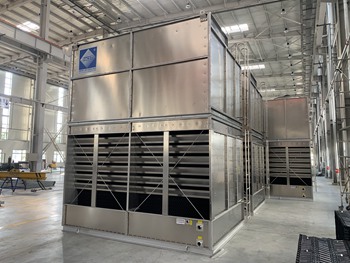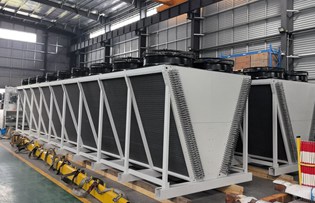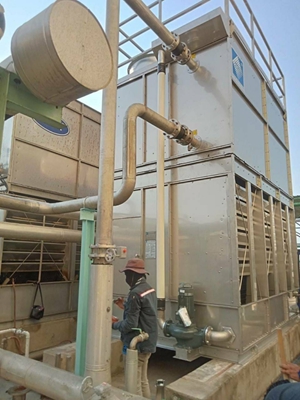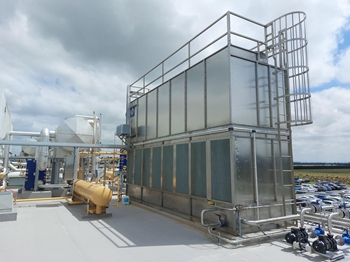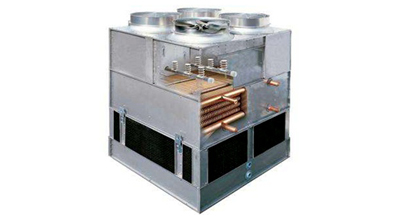Evaporative Condenser
How does Evaporative Condensing Work?
Evaporative condensing functions by harnessing the cooling power of evaporation to enhance the heat dissipation process. This is achieved by spraying water onto the condensing coil from above, while simultaneously blowing air up through the coil from below. This natural process effectively lowers the condensing temperature. Consequently, the compressor workload is reduced.
This results in improved system efficiency and significantly lower energy consumption compared to air-cooled alternatives. Notably, the decreased compressor kW draw (by 25-30%) combined with potential demand charge savings (up to 30% of a utility bill in certain scenarios) can lead to operational cost reductions exceeding 40% when compared to air-cooled condensers.
What are the advantages of employing an evaporative condenser in refrigeration applications?
An evaporative condenser represents a remarkable advancement in refrigeration processes, offering numerous benefits. Firstly, it serves as a comprehensive solution by integrating the functions of both a cooling tower and a condenser, streamlining the system’s design. This consolidation minimizes the space required for installation, particularly advantageous in facilities with limited space availability.
Moreover, the system’s energy efficiency is noteworthy. By harnessing the natural process of evaporation to cool the refrigerant, an evaporative condenser consumes less energy...
What is evaporative cooling?
In the field of refrigeration, there is a device that is vividly called “evaporative cooling”, the full name of which is evaporative condenser. It is like an efficient magician, which can magically transform gaseous refrigerators into liquids, providing indispensable cooling support for many industries.
First, let’s explore why evaporative cooling is so named. In the internal structure of evaporative cooling, a circulating water pump is hidden in the lower part. This water pump is like a beating heart, constantly transporting water to the top of the refrigerator inlet. Then, the water is sprayed on the surface of the internal pipe, as if covering the pipe with a layer of cool water curtain. When this water encounters the high-temperature refrigerant in the pipe, a wonderful “evaporation” phenomenon takes place.
The refrigerant begins to evaporate under the catalysis of high temperature, and the temperature of the refrigerant drops rapidly during this process. At the same time, the fan on the top of the evaporative cooling also joins this “performance”, blowing strongly, driving the air to flow faster. This flowing air is like a diligent cleaner, constantly taking away the water vapor near the water surface, further reducing the partial pressure of water vapor, and providing a continuous source of power for the continuous evaporation of water.
Under a certain pressure, as the heat of the refrigerant continues to be lost, the thermal...
Working principle of dry cooler
The working principle of dry cooler is mainly based on the principle of heat exchange. Specifically, there is a circulating refrigerant flowing through the pipes inside the dry cooler, and these pipes are usually designed as a structure with efficient heat dissipation. When the high-temperature refrigerant flows through these pipes, the fan or natural wind outside the pipe will blow the air over the surface of the pipe to form a heat exchange.
In this process, the refrigerant transfers heat to the outside air through the pipe wall, so that the temperature of the refrigerant is reduced, thereby achieving the cooling effect. The outside air warms up because it absorbs the heat of the refrigerant, and is then discharged or dissipated naturally.
This heat exchange process is carried out continuously, and the refrigerant circulates in the dry cooler, continuously releasing heat, thereby keeping its temperature at a low level. In this way, the dry cooler can effectively reduce the temperature of the liquid and achieve the purpose of cooling.
It should be noted that the dry cooler does not consume water during operation, so its water-saving performance is very obvious. At the same time, since the heat exchange is carried out through the air, the dry cooler will not produce water mist or water droplets during operation, so that it can also be used in some environments with high humidity requirements.
In general, the dry cooler uses the principle of heat exchange and the temperatur...
The difference between dry cooler and condenser
1. Definition and working principle of dry cooler and condenser
Dry cooler and condenser are both important components of air conditioning system. Their function is to cool the high temperature and high pressure gas generated by the compressor into liquid, change the state of the refrigerant, and thus achieve the cooling effect.
Dry cooler, also known as air cooler, is a device that uses a fan to force air cooling on the high temperature and high pressure gas discharged from the compressor. Its working principle is to introduce the refrigerant gas discharged from the compressor into the dry cooler through a pipeline, and then contact the aluminum fins arranged in the air duct through the internal copper tube, and use the fan to force air cooling to quickly cool the refrigerant gas and turn it into a liquid state of refrigerant in the evaporator.
The condenser is one of the most critical components in the refrigeration system besides the compressor. It is mainly used to condense the refrigerant gas into liquid and reduce the workload of the compressor. Its working principle is to directly exchange heat between the refrigerant gas in the condenser and the outside world through the condensing tube, so that the refrigerant gas is quickly cooled and turned into a liquid state of refrigerant inside the condenser.
2. Differences between dry coolers and condensers
Although both dry coolers and condensers cool refrigerant gas into liquid, there are still some differences between th...
Comparison of water cooling and evaporative cooling
Evaporative condenser: The principle of evaporative condenser is to use the evaporation of part of the water to take away the heat released by the condensation process of gas refrigerant. Its shell is a rectangular box of thin steel plate, which contains condensing coil group, water sprinkling device, water retaining fence, water collecting tray at the bottom, circulating water pump outside the box, centrifugal fan or axial fan on the top or side of the box. In addition, there is a float valve in the water tray. When the water is continuously evaporated and the water level in the water tray is too low, the float valve will automatically open to replenish cooling water. Refrigeration system cycle: Compressor exhaust Evaporative cooling condenser Throttling Evaporator Compressor suction
External environment
Water-cooled condenser: After the circulating cooling water is cooled by the cooling tower, it is pumped into the condenser to cool the high-temperature refrigerant, and then returned to the cooling tower for cooling. Refrigeration system cycle: compressor exhaust water-cooled condenser throttling evaporator compressor suction
Water-cooled cooling tower
2 External environment Evaporative cooling and the external environment are primary heat exchange, and water-cooled condenser and the external environment are secondary heat exchange, so evaporative cooling can obtain a smaller heat exchange temperature difference.
2. Advantages and disadvantages analysis
Advantages:
1. Co...
Are closed circuit cooling towers the same as evaporative condensers?
Closed cooling towers and evaporative condensers (evaporative cooling for short) are two common cooling devices in industry. What are the similarities and differences between the two?
1. From the appearance
From the appearance, the closed cooling tower and the evaporative condenser are made of the same material and have a very similar structure. In a sense, the closed cooling tower is an evaporative condenser.
2. Differences in working principles
The closed cooling tower is a heat exchange device that removes heat by cooling the heat medium in the tower. It uses two circulating cooling methods that are completely isolated from the inside and outside. Through multiple heat exchanges between spray water and cold air, the temperature in the tower is reduced, and then the latent heat of vaporization is used to cool the internal circulating water.
Evaporative condenser is a device that uses the principles of evaporation and condensation to complete heat transfer. Evaporative condensers are usually used in refrigeration and air conditioning systems to cool high-temperature and high-pressure steam into liquid. Its working principle is that by placing high-temperature and high-pressure steam in the condenser, the steam will dissipate heat and gradually cool down, thereby turning into a liquid.
3. Different heat transfer methods
The closed cooling tower cools by transferring heat between the spray water and the cooled medium.
The evaporative condenser uses the heat transfer during ...
Matters Needing Attention in Cooling Tower Engineering Application
Notes for Applications
1.Install location:
Closed Circuit Cooling Towers requires abundant supply of fresh air to flow through the air inlets. If the cooling tower is located near to the wall or it is put in a sealed space, you have to take actions to make sure the searing, saturated air will not turn around and flow into the air inlets again.
2.Compatibility of the liquid(gas)
The fluid(gas) to be cooled must be compatible with the coil material. Otherwise it will undermine or corrode the condensing coils. In addition, the coils require high-pressure water cleaning or mechanical cleaning. So the coils must be designed to adapt to this case.
3.Pipes and valves
The pipe must be designed and installed in accordance with the design standard. All pipes must be supported by piping hangers or other supporting equipment. External stop valve may be required if the system requires to isolate individual units.
4.Fluid(Gas) capacity control
The performance of majority equipment vary dues to the change of its environment wet bulb temperature. Therefore, fluid(gas) capacity control is required to make up for the temperature deviation of fluid(gas) due to the environment temperature difference.
The easiest way to control capacity is to make sure the periodic running of the fan, this is usually applied in multi-fan system or multi-unit system. It is applicable to the application with low requirement for the outlet water temperature since the periodic running is easy to control and is abl...
Central air conditioning cooling tower, three temperatures determine heat dissipation, why can it cool when the water temperature is lower than the air temperature
การติดตั้งคูลลิ่งทาวเวอร์ในประเทศไทย
ตั้งแต่ปี 1975 บริษัท HACST Cooling Tower ได้จัดหาคูลลิ่งทาวเวอร์ที่ได้รับการออกแบบทางวิศวกรรมอย่างแม่นยำซึ่งทำงานได้ดีในทศวรรษต่อๆ ไป เทคนิคการออกแบบและการก่อสร้างของเรายึดถือมาตรฐาน CIT อย่างเคร่งครัดตั้งแต่เริ่มแรก เรามีประสบการณ์การก่อสร้างและความเชี่ยวชาญในการก่อสร้างและติดตั้งระบบอย่างกว้างขวาง
เรามีประวัติศาสตร์และประสบการณ์มากกว่า 40 ปีในการผลิตคูลลิ่งทาวเวอร์ และเรายังคงวิจัยและพัฒนาผลิตภัณฑ์ของเราต่อไป ผลิตภัณฑ์ที่จดสิทธิบัตรของเราได้รับการยอมรับทั้งในและต่างประเทศ ผลิตภัณฑ์ของเราได้รับการติดตั้งทั่วโลก และมีกรณีโครงการจำนวนมากทั่วโลก เราเป็นสมาชิกของ Refrigeration Technology Institute (CTI) และการออกแบบของเราเป็นไปตามมาตรฐาน CTI
Cooling Towers in Singapore
HACST is a cooling tower manufacturer and expert ready to serve projects in Singapore.
40 years of experience in cooling tower manufacturing, installation and maintenance. We have a full range of more than 10 cooling tower models that are fully customizable to meet your needs. We have completed many projects in Singapore, including hotels, shopping malls, cold storage, chemicals, pharmaceuticals, etc. You can contact our local agents and we will provide you with the most suitable cooling solution.
Reasons why the temperature of industrial circulating water cannot be lowered
The reasons why the water temperature of a closed cooling tower cannot be lowered may involve multiple aspects. The following is a detailed analysis of these reasons:
1. Insufficient air volume
Fan problem: The fan is a key component that accelerates the air flow in the tower and increases the heat exchange between air and water. If the fan size is not appropriate or the installation position is improper (such as the cooling tower is placed indoors or there are obstructions at the air inlet), the air volume will be insufficient, thereby affecting the heat exchange efficiency and preventing the water temperature from being lowered.
Fan failure: Fan blade deformation, breakage, bearing damage or transmission device failure (such as belt loosening, breakage), etc., may all lead to reduced air volume, thereby affecting the heat exchange effect.
2. Uneven spraying
Spray head blockage: Spray head blockage will cause uneven spraying, resulting in insufficient water in some areas and reducing the cooling effect. The spray head should be checked, cleaned or replaced regularly.
Water distribution trough problem: If the water distribution trough is not designed properly or fails, it may also cause uneven spraying.
3. Improper selection
The manufacturer did not fully consider the specific working conditions of the customer when selecting the model. For example, the model of the cooling tower will be different if the electric furnace is placed in a different position.
Therefore, when c...
Common parameters for cooling tower calculation
Cooling amplitude definition
The cooling amplitude refers to the difference between the cooling tower outlet water temperature and the inlet air wet bulb temperature. A smaller cooling amplitude usually means a higher performance cooling tower.
Efficiency considerations
When evaluating cooling towers, its efficiency is also an important indicator. An efficient cooling tower can more effectively reduce the water temperature, thereby ensuring stable operation of the system.
Cooling tower capacity
The capacity of a cooling tower is usually measured in “kilocalories per hour” or “tons of cooling”. The calculation formula is: Cooling tower capacity = cooling water mass flow × water specific heat capacity × temperature difference. Generally speaking, a cooling tower with a larger capacity has a higher performance.
Make-up water calculation
The make-up water volume is an important factor to consider in the operation of a cooling tower. It includes evaporation loss, splash loss, and periodic discharge loss. The amount of water lost by evaporation can be calculated by the formula E = Q/600 = (T1-T2)×L/600, where E represents the amount of water evaporated (kg/h), Q represents the heat load (Kcal/h), 600 represents the latent heat of evaporation of water (Kcal/h), T1 and T2 represent the inlet and outlet water temperatures (℃), and L represents the circulating water volume (kg/h). The amount of water lost by splashing is usually about 0.1~0.2% of the circulat...
Double circulation principle of closed cooling tower
Double circulation principle of closed cooling tower
The cooling principle of closed cooling tower involves two cycles: internal circulation and external circulation. Its core component is the copper tube surface cooler, which does not require filler.
① Internal circulation: This cycle is connected to the target equipment to form a closed circulation system in which the circulating medium is soft water. Its main task is to cool the target equipment and discharge the heat in the equipment through the cooling unit.
② External circulation: This cycle is designed for the cooling tower itself and does not come into direct contact with the internal circulation water. It only exchanges heat and dissipates heat through the copper tube surface cooler to reduce the temperature of the cooling tower. In this cycle, the motor operation is automatically controlled by the water temperature.
In spring and summer, when the ambient temperature is high, the two cycles usually need to run at the same time. In autumn and winter, due to the low ambient temperature, in most cases, only the internal circulation needs to be started to meet the needs.
Cooling tower type: closed cooling tower
Closed cooling tower, as a highly efficient cooling equipment, is widely used in many industrial fields. Its unique design and operating principle enable it to perform excellent cooling effects in different seasons and environments. At the turn of spring and summer, when the ambient temperature gradually rises,...
Installation method of cooling tower
When installing a cooling tower, it is necessary to select a suitable installation location according to the various conditions of the equipment and ensure that the ground has sufficient load capacity. At the same time, external conditions such as ventilation should also be considered. During the installation process, a horizontal steel plate should be pre-buried as the foundation according to the specified size, and the elevation of each foundation point should be ensured to be on the same horizontal plane. The tower body should be placed horizontally to prevent the chassis from being crushed. When installing the tower shell, chassis and other components, in order to prevent deformation, screws can be inserted first and then tightened step by step. In addition, care should be taken to avoid poor ventilation and humid air backflow to ensure that the cooling capacity of the cooling tower is not affected.
Usually, the cooling tower is installed on the roof of the refrigeration station to form a high pressure head to overcome the resistance loss of the condenser. The water pump draws cooling water from the pool and sends it to the cooling tower for cooling treatment. The cooled water is then pressed into the condenser by gravity for circulation. During installation, it is necessary to position it according to the coordinate position specified in the construction drawing, and level and align it to ensure that the equipment is stable and firm. At the same time, attention should...
Selection of cooling towers
Selection of cooling towers
When selecting a cooling tower for a particular device or system, a series of steps need to be followed. First, the total amount of heat rejection of the fluid must be determined, usually measured in Kw/h. Second, the desired inlet and outlet water temperature difference must be determined, which is particularly important in air conditioning projects because different cooling methods have different temperature difference requirements. For example, absorption chillers are generally set at a temperature difference of 8°C, while compression refrigerants are usually set at 5°C.
Next, a specific formula is used to calculate the required cooling water volume in m3/h. This formula involves multiple parameters such as the total amount of heat rejection of the fluid, the temperature difference, and the specific heat of water. It should be noted that different cooling methods use different coefficients in the calculation, such as 3.0 for absorption chillers and 1.56 for compression refrigerants.
In addition, local meteorological conditions, especially wet bulb temperature, need to be considered. When the wet bulb temperature is less than 27°C, there is generally no need to increase the design margin. However, if the atmospheric wet bulb temperature at the installation site is higher than this value, the design needs to be adjusted accordingly.
Let’s take a specific example: when selecting a cooling tower for a lithium bromide refrigerator with a coo...
Cooling Towers in Indonesia, Asia
We have been specializing in the production of cooling towers for more than 40 years, although when you go online you will find several companies that specialize in the production of cooling towers. , you can also find various portals that display a list of the top 10 cooling tower manufacturers, but it is easy to get confused when buying a cooling tower.
We are one of the top cooling tower manufacturers in Indonesia in terms of design, manufacturing, installation and maintenance of closed cooling towers. We have agents in Indonesia and we have undertaken many projects locally, including in the petrochemical industry. Food industry, pharmaceutical industry, etc.
Our advantage:
* Innovative design using the latest cooling tower technology.
* Industry leader, we have built over 20,000 cooling towers.
*Conservative thermal ratings.
* Long life structure.
* Compact yet powerful weatherproofing.
* Proven and reliable.
* Simplified maintenance.
Noise reduction treatment of cooling towers
Noise reduction treatment of cooling towers
The noise sources of cooling towers mainly come from four aspects: fan intake and exhaust noise, water spray noise, fan reducer and motor noise, and cooling tower water pump, piping and valve noise. Among them, falling water noise is a unique noise source of cooling towers. It is a steady-state water noise generated by the large-scale continuous liquid impact of cooling falling water on the pool water in the tower.
The sound source sound level of this noise is about 80dB (A), and the spectrum is mainly composed of high-frequency (1000-16000 Hz) and medium-frequency (500-1000Hz) components, with a peak at around 4000Hz. Due to the long wavelength of sound, strong penetration ability, and insignificant sound attenuation, it is difficult to control.
On the other hand, the turbulence and friction-induced pressure disturbances generated by the air in the top guide pipe of the cooling tower, as well as the vibrations generated by the blades and the air, will radiate noise outward. These aerodynamic noises are one of the main sound sources of cooling towers.
In addition, falling water noise is also a noise source that cannot be ignored. When the circulating water of the cooling tower falls freely through the packing layer to the water trough, impact noise will be generated, and its intensity is proportional to the square of the water speed. The measurement results show that the A-level noise of the falling water reaches 70dB, which is a...
Градирня закрытого типа
Градирня закрытого типа, в отличие от открытой градирни, имеет замкнутое пространство теплообменных труб (радиаторы из гальванизированной или нержавеющей трубы), где и циркулирует охлаждаемая жидкость.
В закрытых мокрых градирнях охлаждаемая вода остается всегда чистой – рабочая жидкость не вступает в контакт с воздухом, а герметичные радиаторы защищают от загрязнений. Подаваемая из чаши насосом вода омывает радиатор конденсатора с воздушным охлаждением и передает тепло потоку воздуха, циркулирующему внутри градирни с помощью радиальных вентиляторов .
1. Мощные вентиляторы позволяют устанавливать в градирне несколько рядов теплообменника, за счет чего теплопередающая поверхность увеличивается, а температура максимально снижается.
2. Специальный конструктив градирен с высокой охлаждающей способностью (противоточная компоновка наиболее эффективна для теплообмена). На всасывании воздуха обеспечивается равномерность распределения воздушных потоков, за счет чего достигается высокий КПД градирни.
3. Эффективная водораспределительная система:
— уникальная форма форсунок, которые устанавливаются в определенном порядке друг напротив друга (факел распыла), обеспечивает равномерный расход воды и эффективное ее распыление по всей теплообменной поверхности.
Development Trend of Cooling Tower
China’s industrial technology level has also continued to mature. The demand for cooling tower production has continued to increase, and the level of localization has been increasing. Under the country’s call for vigorously advocating resource conservation and environmental protection, cooling towers are developing towards energy conservation and environmental protection.
Cooling tower noise has always been the biggest drawback. Many technologies have not achieved noise-free effects, but the latest research and development of fanless cooling towers can be achieved. This energy-saving and environmental-friendly cooling tower is the future development aspect of the cooling tower industry. Once it is widely used in industrial production, it will be respected by more companies.
After China’s entry into the WTO, in order to better participate in international competition and be in line with international standards, the country has planned a large-scale adjustment and reorganization of the cooling tower industry, including the formation of large groups that combine production, education, and research. The country has continuously introduced high-tech and high-quality cooling tower products, and it is necessary to computerize and modularize the design, selection, quotation, and cost management of wet and dry cooling towers, and to take advantage of the price advantage of domestic products. This can not only occupy the domestic market It is also possible to rush ...
